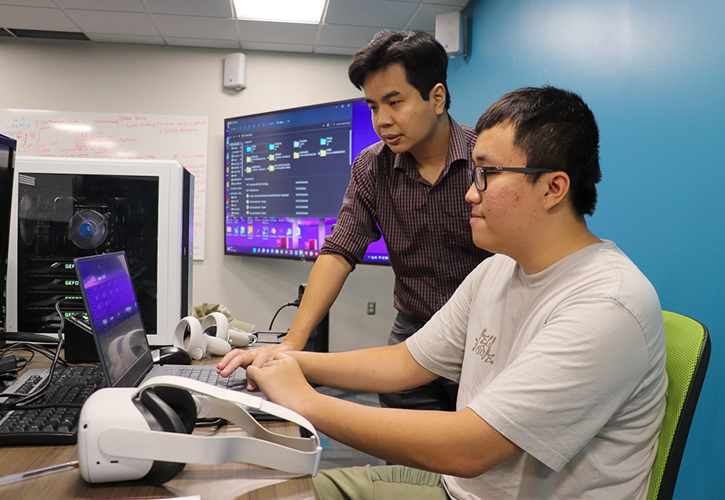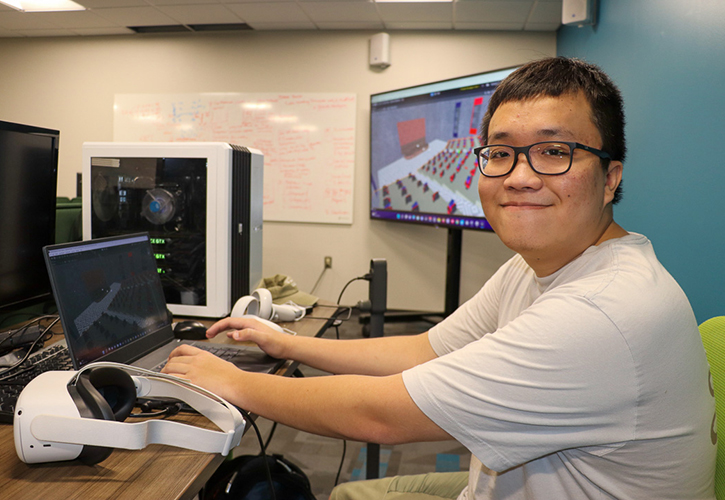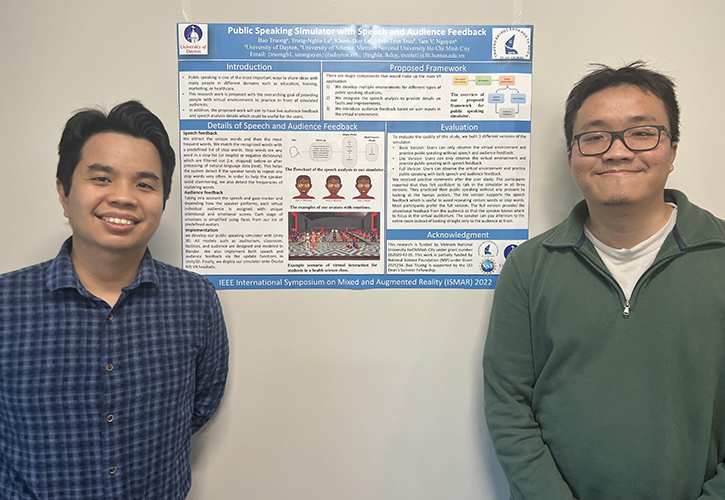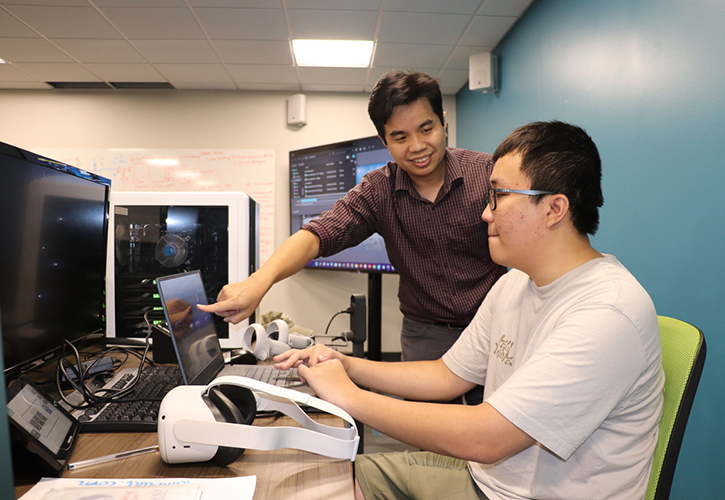Dayton Engineer
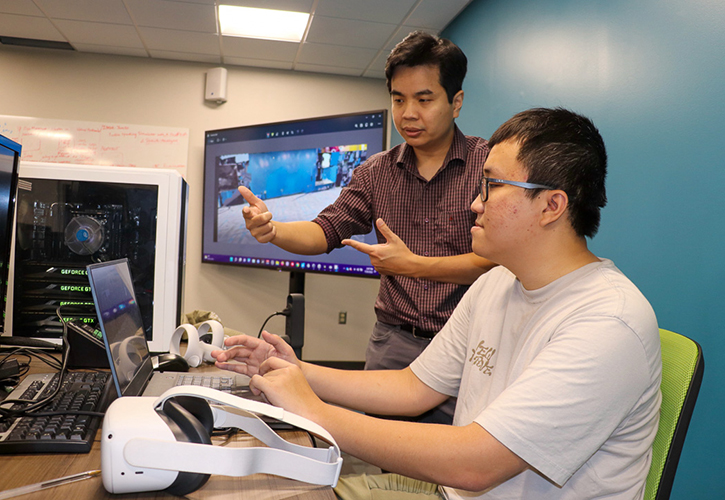
Computer engineering student creates public speaking simulator with faculty mentor
By Bridgett Dillenburger ’23
Inspired by his own struggles with public speaking, University of Dayton junior Bao Truong created a virtual reality simulator to allow users to practice presentations before a computer-generated crowd.
Truong, a computer engineering major from Englewood, Ohio, developed his public speaking simulation with faculty mentor Tam Nguyen through the College of Arts and Sciences Dean’s Summer Fellowship program. He has worked for two years with Nguyen, associate professor of computer science. Their work is supported in part by a $16,000 Research Experiences for Undergraduates award from the National Science Foundation.
“I don’t love going on stage, but after taking communication classes at school I learned that practicing helps you a lot, so I wanted to give people a space to practice with feedback,” Truong said. “It is a skill that you work on over time and this is something in the future that could help people.”
Truong created a poster on his research for the 2022 IEEE International Symposium on Mixed and Augmented Reality in Singapore.
“I discussed this research with many researchers and professors,” Nguyen said. “They really loved the idea of using the public speaking simulator with audience feedback and speech feedback as well. Normally, we have software programs doing this, but they are not free, and they are not giving you much useful feedback.”
Truong built an application for the Oculus VR headset that runs without a computer to allow users freedom of movement while speaking. He created three virtual environments for the simulation featuring an auditorium, a classroom and a scan of Nguyen’s lab. They include virtual audiences, which he hopes to make more interactive with real-time reactions in the future.
“Public speaking with a real environment that you scan into the application has never been done before, so I am trying to implement that,” he said. “Based on what you say in the simulation, you then receive the feedback you need to improve your speech.”
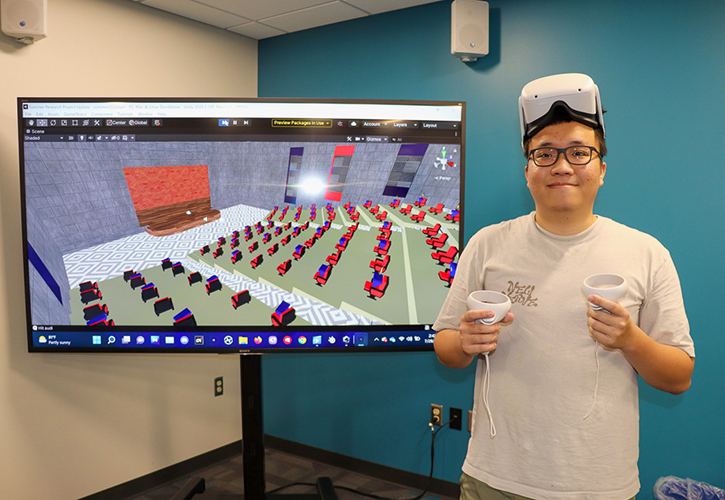 Truong also is working on a voice log analysis that scans speech content and identifies unique and most frequently used words. This can help provide feedback on details such as speaking rate and grammar. In addition, he hopes to implement a gaze tracking system to monitor eye movement.
Truong also is working on a voice log analysis that scans speech content and identifies unique and most frequently used words. This can help provide feedback on details such as speaking rate and grammar. In addition, he hopes to implement a gaze tracking system to monitor eye movement.
“When you have a conversation with people, like in public speaking, you have to keep track of looking at someone in your audience to keep them engaged,” he said. “It can count how many times you look in this direction or that direction, and whether you are looking at specific people or the general body.”
The Dean’s Summer Fellowship program provides an opportunity for undergraduate students in the College to conduct summer research in any academic discipline under the guidance of a faculty mentor. Truong was invited by Nguyen to work under his mentorship after his first year.
“Getting started in research is hard without a mentor, so I felt super lucky to meet him through my classes and get his help throughout my college experience,” Truong said.
Truong said this mentorship opportunity has allowed him to learn from Nguyen’s research experience, giving him more direction during his undergraduate career.
“Starting off as a freshman in college, I don’t know what I would have done,” he said. “This gave me a path to work toward.”
Truong said working with Nguyen has opened him up to new connections and opportunities. In addition to the Singapore symposium, he presented his research poster at UD’s 2022 Summer Undergraduate STEM Research Symposium and the 2022 Stander Symposium.
“Most college students don’t have the opportunity to do this sort of research and that’s really something that stands out,” Truong said. “After working on this project, I’ve been to career fairs where I was able to talk to recruiters about the work I’ve done, and they really liked it.”
Truong hopes to conduct a user study once the public speaking simulator project is finalized. He is considering integrating this research into his capstone project, but he may release it as an open source VR project for public use.
Truong continues to work with Nguyen during the school year on research funded through the NSF grant. Truong plans to do an internship next summer to get more real-world experience with hardware-related work.
“All students can do research,” Nguyen said. “If you want to do something big in the future, you have to start with something small first and the Dean’s Summer Fellowship is a good starting point.”

